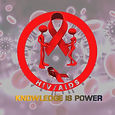HIV Life Cycle
HIV-1 entry into CD4+ cells is mediated by the chemokine receptor CC-CKR-5. The β-chemokines MIP-1α, MIP-1β and RANTES inhibit infection of CD4+ cells by primary, non-syncytium-inducing (NSI) HIV-1 strains at the virus entry stage, and also block env-mediated cell–cell membrane fusion. CD4+ T cells from some HIV-1-exposed uninfected individuals cannot fuse with NSI HIV-1 strains and secrete high levels of β-chemokines. Expression of the β-chemokine receptor CC-CKR-5 in CD4+ , non-permissive human and non-human cells renders them susceptible to infection by NSI strains, and allows env-mediated membrane fusion. CC-CKR-5 is a second receptor for NSI primary viruses.
The seven stages of the HIV life cycle:
1) binding 2) fusion, 3) reverse transcription, 4) integration, 5) replication, 6) assembly, and 7) budding.
HIV uses CD4 molecule as a receptor which is present in CD4+ cells such as T-lymphocytes, macrophages, monocytes, dendritic cells other and Antigen presenting cells.
A second co-receptor in addition to CD4 molecule is required for HIV to gain entry into host cell. CCR5 for macrophage tropic HIV and CXCR4 for T-lymphocyte tropic HIV.
HIV first binds to CD4 molecule mediated by surface glycoprotein gp120 and then to the corresponding co-receptors CCR5 or CXCR4. This binding brings conformational change in viral envelope inducing the binding of gp41 of virus into host cell membrane and triggering the entry of virus into host cell.
Once the fusion of virus takes place with the host cell, viral RNA is released into the cytoplasm.
Viral RNA is then used to synthesize ds DNA by the enzyme reverse transcriptase (RNA dependent DNA polymerase). The ds DNA is then circularized and enter into host cell nucleus.
This circular ds DNA get integrated with host genome and the process is catalyzed by the enzyme Intergrase. This type of integrated viral DNA into host DNA is known as Pro-virus.
Once the viral DNA is integrated, infection of HIV is permanent.
The HIV Virus may then enter into latency or enter into productive cycle.
In productive cycle, the Pro-virus DNA is then transcribed into mRNA by host RNA polymerase and finally translated to viral proteins. These proteins are processed to form virion components which are then assembled.
The progeny virus now matures and release by budding.
During budding, it acquire envelope
The released progeny virus infects suitable host cell and continues the productive cycle.

.jpg)




